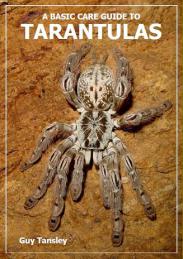
Of the 7 described species
of Tliltocal Mendoza & Francke, 2020 most can be readily found in
captivity. All are terrestrial/burrowing by nature and most are found throughout Central America (Mexico, Costa Rica, Guatemala and Panama etc). Often referred to as 'pet rocks' in the pet trade due
to their docile temperament, they can be very slow growing, taking many years to reach maturity. Some of the longest living tarantulas, there have been reports of individuals living in excess of 30
years so they are definitely a long-term commitment. Some species are considered safe for handling and most make for an ideal beginners choice, adapting well to captivity and relatively hardy. All
possess urticating hair that may cause some irritation but with their placid temperament, most will be reluctant to bite. A typical terrestrial set-up is ideal but should be kept on the drier side
but country of origin should be used as a guide when setting up the captive environment (see below for more detailed descriptions). A cork bark/flowerpot retreat is recommended but most species are
happy to sit out in the open for long periods making them ideal display animals. More on housing can be found here. Breeding can sometimes be problematic and some recommend a winter cooling period (that the
spiders would encounter in the wild) to stimulate eggsac production. Eggsacs commonly contain around 500 very small spiderlings.
Common species in captivity:
T.
albopilosus - (Valerio,
1980) Costa Rica
Commonly called the curly hair in the hobby due to the sometimes long setae that covers the legs that have a somewhat curled appearance. Native to Honduras, Nicaragua and Costa Rica,
T.
albopilosus is typical of
the genus and can be found in burrows usually in tropical forested regions. Reaching approximately 14 cm in legspan and with a docile temperament, it can be considered an ideal beginners species and
although I don't agree with handling any species, this is one that can be considered fairly safe. They feed well throughout their lives, grow rapidly and are long lived captives. Breeding is
straight forward and this means they are quite common in the trade therefore they are usually cheap to buy. Settles well in captivity and rarely hides itself away.
T.
epicureanus - (Chamberlin, 1925)
Mexico
Similar to T.
vagans and from the rainforest
areas of Mexico (Yucatan State).
T.
kahlenbergi - (Rudloff, 2008)
Mexico
Positive identification is difficult as it is very similar to T. vagans.
T.
sabulosus - (F. O. P.-Cambridge,
1897) Guatemala
Positive identification is difficult as it is very similar to T. vagans.
T.
schroederi - (Rudloff, 2003)
Mexico
One of the smallest species in the genus (around 10 cm legspan), T. schroederi is the newest addition to the group. Almost completely black in appearance (except for the carapace that may show some brown), it is a striking
specimen. Males are completely black and captive breeding is in its infancy with this one but with any luck, spiderlings will be available in the future. Voracious feeders, they can tackle prey
larger than themselves and they grow relatively fast.
T.
vagans - (Ausserer, 1875) Mexico,
Central America
A wide ranging species throughout Central America - Guatemala, Yucatan, Belize and Honduras, T. vagans juveniles can grow quite fast but can still take several years to reach maturity (up to a 13 cm legspan). Adults can go for
long periods without eating and specimens have been known to moult only every two years. Quite common in captivity as breeding is easy with the courtship being a very deliberate affair with no risk
to the male if the female is receptive. Multiple matings are common. Recommended beginners species, not overly aggressive but nervous and for this reason, shouldn't be
handled.
T. verdezi - (Schmidt, 2003) Mexico
A large species that is coloured overall golden brown but with light brown long hairs covering the abdomen. The carapace can sometimes have a dark triangle that extends from the fovea to the front
edge around the eyes. Captive breeding is becoming more common for this species so captive bred spiderlings should be available. Until recently this species was sold
as Aphonopelma
pallidum until a recent
revision.
